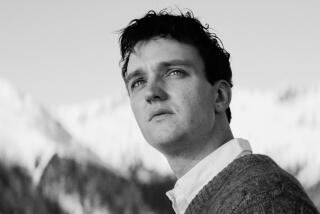Gerhard Richter’s Hat Trick : For this protean German artist, the only constant is change
- Share via
SAN FRANCISCO — Things are not what they seem. Take Gerhard Richter. When you travel to West Germany his paintings are as much a staple of museums’ contemporary galleries as, say, Andy Warhol or Frank Stella. The difference is that whether you are in Dusseldorf or Cologne, Stuttgart or Hanover you always recognize the Warhols, Stellas and other products of the brotherhood of the international art franchise. Art museums’ contemporary galleries are as homogenized as Burger Kings.
Gerhard Richter is different. You always wonder if this Richter in Berlin is the same Richter you saw in Frankfurt. That Richter painted a black-and-white snapshot scene of a family of burghers at the beach. This Richter paints massive Abstract Expressionisms. Can it be the same chap, der selbe Kerl? You can run around for years wondering if Gerhard Richter is one guy or a family. But in that case wouldn’t you have Richter der Junge and Richter der Alte , as with the Holbeins? Maybe he is a corporation.
The question nags in the back of the mind like the name of a 1940s character actor you just can’t remember. Now finally, and at last, the San Francisco Museum of Modern Art performs a great public service in presenting a traveling retrospective of Gerhard Richter’s art (through May 28). Some 70 works spanning more than two decades prove he is indeed one discrete free-standing person. He just changes hats a lot.
It’s a relief to have that cleared up, but no sooner is one veil removed than another falls in its place. Enigmas are like that.
Why has Gerhard Richter gone on changing? Artistic convention holds that its practitioners must maintain a certain consistency of style. The most famous modern artist to break this rule was Pablo Picasso but through all his changes his work maintained a certain trademark look. An artist’s manner is supposed to express his integrity, character and personality. If, for example, we have a friend whose natural personality is a bit like John Wayne’s we do not expect him to suddenly start behaving like Bette Midler. If he does, we assume he’s a terrible poseur, has gone mad or is putting us on.
Richter bobbles around from photo-based Pop images of cows to color-chart rectangles to gentle pastel landscapes to panes of glass suspended in metal frames and back to portraits of famous men. The first nasty suspicion is that he is a familiar sort of artistic opportunist who changes style to exploit the current fashion.
But things are not what they seem. An aesthetically innocent girl walks through the gallery singing Richter’s praises for doing so many different things so well. Any artnik with an ounce of objectivity then realizes he is operating with a load of mental baggage that may do as much to block insight as to create it. Just another Pirandello character who is only right because he thinks he is.
Besides, the chronological evidence doesn’t altogether support the supposition that Richter is a camp-follower. It tends to support the other, drearier, supposition that he is a pedant. An early work from 1966 depicts a nude young woman descending a staircase in a blurry Photorealist style. It clearly refers to modern art’s greatest intellectual and ironist, Marcel Duchamp. Nearby hangs another 1966 work of radically contradictory appearance--a color chart. Just rectangles of color. That’s all, folks.
It appears we have fallen into the clammy clutches of a conceptual artist. It appears that Richter is interested in “questioning the act of perception.” It appears we are going to once again be the victim of that suffocating scold about how all art is a meaningless illusion. It must be very depressing to make a career of telling the world your work is worthless.
Catalogue essays in Teutontic style prop up this hypothesis surrounding Richter’s art with ponderous palaver about semiotics, demythification and appropriation. We are informed that the artist has been actively engaged in an attitude of nihilism. Wow, Nihlism, I bet nobody’s thought of that since Nietzsche. Good thing, too.
It’s certainly possible to read Richter’s art as an act of neutralization. If we buy the intellectual script attached to it, then Richter’s habit of using traditional painting as a vehicle for vanguard ideas is indeed an attempt to attain a state of perfect expressive nothingness. In that case there is nothing to do but go home and nurse the massive migraine induced by an art of suicidal denial.
Fortunately, things are not what they seem.
Good news. It appears that Richter has expressed himself in spite of himself. If you forget all the surrounding guff and just look at the art, it is never uninteresting. It also implies a brave and difficult personal odyssey.
Gerhard Richter was born in Dresden in 1932. The most superficial memory of recent history suggests his childhood cannot have been any picnic, what with fire-bombings and the city winding up on the wrong side when it was all over. Somehow he survived it and remained in the Eastern zone where he was trained in the dreary artistic discipline of Socialist Realism. No wonder he made his way to the West in the ‘60s.
All that suggests a much more plausible understanding of his early art than arid art theory. The gray flatness of his earliest work suggests authentic depression. The emotional deadness of art copied from blurred newspaper photographs feels like a literal transcription of the inner state of a traumatized refugee. He muses on the impersonality of modern victimization in grimy images of a murdered prostitute or eight student nurses slaughtered in Chicago. He is preoccupied with violated innocence, but the pictures also have a weird erotic charge that is denied. Feeling is just too painful, so there is an escape into rationalization and art games.
Something else happens in aerial landscapes that want to play at being real views and brushy abstract paintings at once. One pictures downtown Madrid. Given traditional German leanings to symbolism, it is no doubt an evocation of another country that fell to fascism, but something more important happens. Despite its grayness the work takes pleasure in its own juicy thick paint. Emotion stirs.
Then come a series of soft pictures in pastel shades--big candles, a skull, a churchyard and views of the German landscape and sky. They evoke the great Romantic Caspar David Friedrich and throb with Heimweh-- an almost religious homesickness for an idealized Germany that may never have been. Feeling is alive in these touching pictures.
Maybe it was too much for him because the ‘70s saw a retreat into colorless Minimalism, goopy fields of gunmetal gray, big panes of glass. After all maybe it was a concession to fashion. People are complicated. Faces painted from photographs also return but with a new twist. Richter made a huge wall of 48 portraits of famous men of the modern era ranging from H. G. Wells to Anton Bruckner.
Clearly conceptual, the work touches many things, including a erman preoccupation with history and documentation. Richter’s version looks very public but comes across as a personal rumination. The faces--as faces--clearly are meaningless. What counted with these men were their works, their ideas, and overriding all that the fact they were all so authentically and obdurately themselves.
Richter must have decided to take the example because his latest work is astonishing. He has taken to making very large Abstract Expressionist paintings whose existence can only be accounted for by the artist’s decision to finally feel and let it all hang out. They do retain a whiff of personal elusiveness in brushwork that can’t be traced to the human hand--big swaths of paint that must have been made with a broad squeegee. The paintings look blown up like enlarged fragments from microscopic photographs. They mix geometric elements with brushy areas and flat and deep space. They mix the sublime aspirations expected of abstraction with a vulgarity so coarse it has to be conscious. They are colored the fluorescent hues of a kitsch carnival at night.
You can feel the artist’s gusto in a wildly theatrical picture that seems to unfurl a red Baroque drapery revealing a blinding yellow sun on one side, a teeming landscape on the other. He lets himself be tense and complex in the apocalyptic wave of “Net.” Just to make sure we know he knows what he’s doing, he calls more than one picture “Courbet,” connecting himself to the glorious overripeness of the French master.
Richter found out that art is an illusion but not a meaningless one. He discovered that you don’t need issues or trends to make terrific art. If you just paint the socks off something, the endless yardstick of quality will bring it home.
More to Read
The biggest entertainment stories
Get our big stories about Hollywood, film, television, music, arts, culture and more right in your inbox as soon as they publish.
You may occasionally receive promotional content from the Los Angeles Times.










